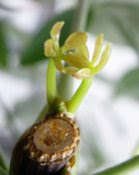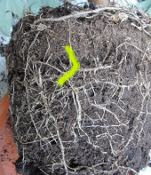 This new growth on the over-watered parasol plant indicates recovery. The plant has not been watered for 17 days.
This new growth on the over-watered parasol plant indicates recovery. The plant has not been watered for 17 days. I don't know if you can see, but the bottom of the compost is still quite damp. So needs no water, yet. However, most of the rest in this 7 inch (17.5cm) pot is almost bone dry, especially the original compost above the lime arrow (the plant has been in this pot about 15 years, but when it fills with roots, I remove the lower part and replace with fresh compost. This has been done two or three times)
I don't know if you can see, but the bottom of the compost is still quite damp. So needs no water, yet. However, most of the rest in this 7 inch (17.5cm) pot is almost bone dry, especially the original compost above the lime arrow (the plant has been in this pot about 15 years, but when it fills with roots, I remove the lower part and replace with fresh compost. This has been done two or three times)This dry compost is probably the cause of the over-watering trouble. Were I to water the pot now, the water would run off the dry compost, straight to the bottom of the pot, leaving the roots once again soggy. I haven't really thought about this before. But perhaps a better plan might be to start spraying the top of the pot with tepid water, thus gradually dampening the compost from the top. This would then allow the roots higher in the pot to become active. And the excess water would gradually seep down.
This wetting of dry soil or compost is a real problem, especially during a dry spell of weather. If you have some dry soil, throw a bucket of water onto it, then scrape away the surface to see what has happened. I promise you, you will be amazed. I certainly was when I first tried it.
No comments:
Post a Comment